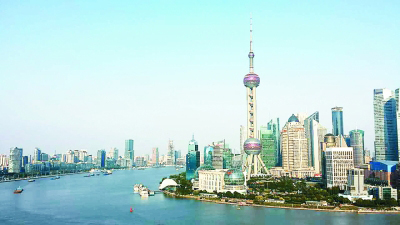Scholar zooms in on development of metropolitan regions

Shanghai, a megacity in China, is leading the development of the Yangtze River Delta Urban Agglomeration. (GUANGMING DAILY)
China’s urbanization rate increased from 52.6 percent to 58.5 percent over the past five years, and during that time, more than 80 million people who have relocated from rural to urban areas have gained permanent urban residency, according to the 2018 government work report. The 19th CPC National Congress report proposes establishing a more effective mechanism to regional development. “We will create networks of cities and towns based on city clusters, enabling the coordinated development of cities of different sizes and small towns, and speed up work on granting permanent urban residency to people who move from rural to urban areas,” says the report.
Cai Jiming, an NPC deputy and professor of political economy from Tsinghua University, was invited to share his view on this issue. He suggested improving strategies for the construction of metropolitan regions.
China currently lags behind in terms of building metropolitan regions, so small and medium-sized cities are not able to fully benefit from the excellent resources of adjacent megacities like Beijing and Shanghai. In this context, potential metropolitan regions in the country have failed to drive the development of the surrounding areas as much as possible, Cai said.
The work needs to comply with the global trend of economic growth and the development principles of endogenous cities. Cai proposed focusing on megacities and promoting development of metropolitan regions under the strategic framework of building city clusters.
A metropolitan region extends about 50 kilometers around megacities. When making the overall plan, developers should also consider building a large-scale rapid rail network connecting megacities and its surrounding small and medium-sized cities. Cai said that such a move would produce great momentum for China’s economic growth in the next phase while attracting more people to live in the area. And the places from which people migrate to megacities can optimize the division of labor based on their comparative advantages, thus increasing the per capita possession of resources and per capita income when the population decreases.
Measures should be taken to settle new citizens and ensure them equal benefit from public service as soon as possible. Cai argued that the process of human migration will unleash substantial demand, creating favorable conditions for expanding consumption. Also, it helps to remarkably improve the educational quality of new citizens’ offspring and make the strategy of human resource into a reality. At present, the number of left-behind kids and those migrating to cities with their parents accounts for about one-third of the school-age children. These adolescents will be destined to become part of the human resource reserve in the future if they can receive quality education.
Meanwhile, established area boundaries should be eliminated within megacities’ administrative areas as a part of the construction of metropolitan regions. As more people arrive, city planners also need to adjust the amount and structure of public services and infrastructure, particularly in central urban areas, to meet the potential demand and ease city malaise. The proper investment in public services and infrastructure can not only stimulate economy in the short term but also yield sustainable rewards in the long run. In this way, economic growth and livable cities can be achieved at the same time, Cai added.
(edited by MA YUHONG)

 PRINT
PRINT CLOSE
CLOSE